Learn Reggae Guitar and the Style of Bob Marley
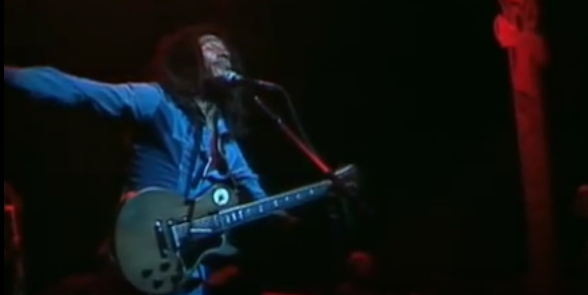
When Bob Marley brought the Jamaican sounds of reggae to the U.S. in the early Seventies, he created a musical revolution.
His first two Island Records releases, Catch a Fire and Burnin’ (both issued in 1973), included the hits “Stir it Up,” “Get Up, Stand Up” and the mega-smash “I Shot the Sheriff,” which when covered in 1974 by Eric Clapton helped catapult Marley to international acclaim.
Following 1974’s Natty Dread (including “No Woman, No Cry”), 1976’s Rastaman Vibration and 1977’s Exodus (featuring “One Love”), Marley was firmly established as one of the biggest pop stars in the world. This edition of In Deep examines the basics of the reggae guitar style as well as specific techniques used on some of Marley’s most beloved songs.
Stylistically similar to funk, reggae is built from distinct musical “puzzle pieces” provided by multiple guitars, bass, keyboards, drums, percussion and vocals. These elements are precisely fit together in the musical arrangements. In terms of the guitar work, one guitar often plays a “scratchy” rhythm part—like a percussion instrument, such as a washboard, snare drum or maracas—while another guitar provides a low, single-note melodic line that is similar to but differs from the bass line.
In sharp contrast to many styles of music, in reggae the bass often provides melodic content while the guitars lay a solid rhythmic grid underneath.
Let’s start with a very basic reggae-style rhythm part (see FIGURE 1). Here, the percussive role of the instrument is made prominent by the accentuation of muted “dead-string” accents, interspersed with a Bm chord voiced on the top four strings. The strumming pattern is steady 16th notes—count “ONE-ee-and-a, TWO-ee-and-a,” etc.—and the chord accents are placed on the eighth-note upbeat of each beat. Also, I release fret-hand finger pressure between the chord accents to make them sound as staccato (short and crisp) as possible.

A great way to make a static rhythm part like this more interesting and musical is to move to different voicings of the same chord (in this case, Bm) while maintaining the steady rhythm. As shown in FIGURE 2, I move up from seventh to 10th to 14th and 19th positions, and then back down. Notice that a subtle melody is alluded to as the highest note in each voicing moves up and down the fretboard.
Now let’s apply this approach to a standard reggae-style chord progression, as demonstrated in FIGURE 3. In this example, one bar of the I (one) chord, Bm, is followed by two beats of the fVII (flatted seventh) chord, A, and two beats of the minor iv (four) chord, Em. This part is made most effective by alternating between a light touch on the muted string strums and a sharp, harder attack on the chord accents.
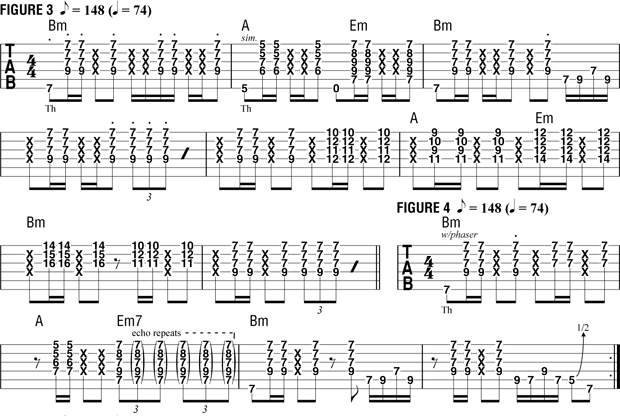
At the end of FIGURE 3, I play eighth-note triplets in a staccato fashion to emulate the sound of an echo effect, one of the common signal enhancements used in reggae guitar. Also used often are wah pedals and phase shifters. In FIGURE 4, I use an analog delay pedal (an MXR Carbon Copy) to provide the eighth-note triplet effect, along with an MXR Phase 90, which changes the sonic texture as the part progresses.


Marley’s classic hit, “One Love,” features rhythm guitar parts during the chorus and verse sections that are similar in execution to the previous examples. FIGURE 5 illustrates a similar part played within a chord progression built from the I, IV and V chords in the key of Bb: Bb, Eb and F. FIGURE 6 adds the relative minor chord, Gm, to the mix.

Another great example of this strumming technique is Marley’s “Waiting in Vain,” which consistently alternates between the I chord in Ab, Abmaj7, and the IV chord, Dbmaj7. FIGURE 7a offers a part along these lines.
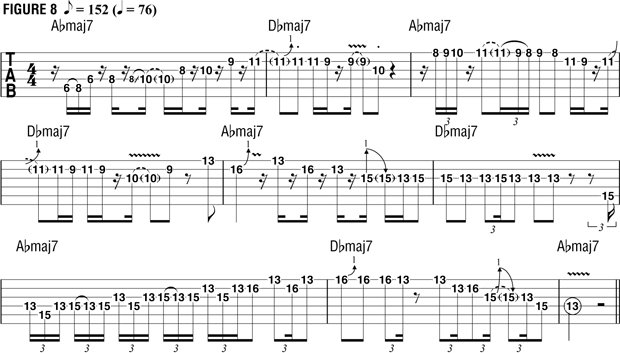
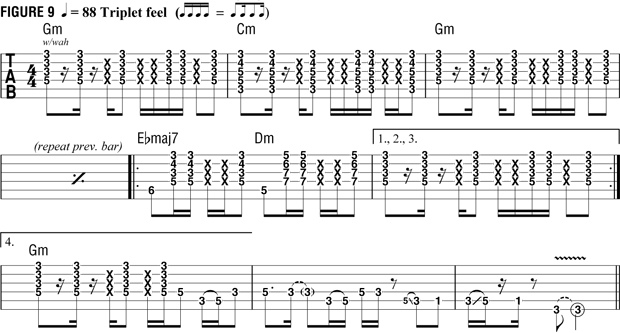
“Waiting in Vain” features a melodic guitar solo, as do other Marley hits, such as “One Love” and “Stir It Up.” FIGURE 8 illustrates a solo along the lines of that heard in “Waiting in Vain,” based primarily on Ab major pentatonic (Ab Bb C Eb F). “I Shot the Sheriff” is built from similar rhythm techniques, but with more complex syncopations, akin to FIGURE 9.
FIGURE 10 offers chord arpeggiations like those heard on “No Woman, No Cry,” and FIGURE 11 depicts an accompanying solo based on C major pentatonic (C D E G A).

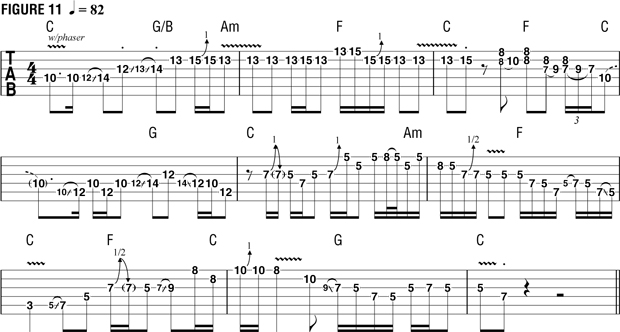
For a comprehensive look at all of the styles covered in this lesson, pick up our In Deep: How to Play Reggae & Funk DVD. Andy Aledort teaches you how to play classic reggae rhythms, chord progressions and music in the style of Bob Marley. Plus, he shows you all the syncopated grooves and hot chords used in the funkiest R&B. Get it in our online store here.
Get The Pick Newsletter
All the latest guitar news, interviews, lessons, reviews, deals and more, direct to your inbox!
Guitar World Associate Editor Andy Aledort is recognized worldwide for his vast contributions to guitar instruction, via his many best-selling instructional DVDs, transcription books and online lessons. Andy is a regular contributor to Guitar World and Truefire, and has toured with Dickey Betts of the Allman Brothers, as well as participating in several Jimi Hendrix Tribute Tours.










![Joe Bonamassa [left] wears a deep blue suit and polka-dotted shirt and plays his green refin Strat; the late Irish blues legend Rory Gallagher [right] screams and inflicts some punishment on his heavily worn number one Stratocaster.](https://cdn.mos.cms.futurecdn.net/cw28h7UBcTVfTLs7p7eiLe.jpg)
